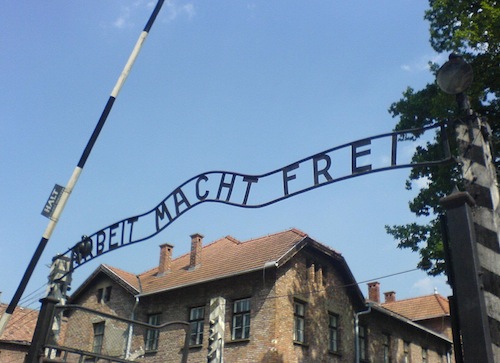It's the Fourth of July. So, why, back in 1941, did Liberty Magazine have this blacksmith hammering on a sword on its cover? The Japanese attack on Pearl Harbor was still six months in the future.
Just for background, Liberty was a very popular magazine back in its day. It was second only to the Saturday Evening Post in the hearts of Americans. Its subtitle was "A weekly for everybody." In the upper left of this cover art, you can see a tiny Statue of Liberty and the words "The American Way of Life".
The Fourth of July in 1941 was the last one before the attack on Pearl Harbor, when the US declared war on Japan, and then on Germany; thousands of American men were soon drafted into the military. For the next four years, the nation technically battled two wars, one in the Pacific and one in Europe and North Africa. Yet this cover doesn't reflect any peaceful innocence of pre-war days. It's calling for a fight.
When this issue of the magazine was published, Winston Churchill was begging for help as London crumbled beneath the blitzkrieg bombs. Jewish refugees continued to plead for rescue. British and Soviet forces invaded Iran to protect access to oilfields needed to fuel their armies and air forces. Japan occupied Saigon and it looked like Thailand would be next.
At first glance, this cover seems to call for the United States to enter the war. But Pearl Harbor was still five months away, and no one knew it was coming.
The week before this magazine appeared on newsstands, a German U-boat attacked an American warship in the Atlantic for the first time. President Roosevelt gave the Navy permission in the future to fire back, although only if fired upon first...if that wasn't too late.
In the age before television and the Internet, magazine covers were powerful billboards, whether they reassured Americans of an idealized and peaceful way of life on the cover of the Saturday Evening Post, or called for political or military action--without saying a word--like this striking cover of Liberty.
What's was the artist's method? He removed Uncle Sam's trademark long-tailed jacket and rolled up his sleeves. He is intent on his job, fully focused on the accuracy of his blow; one eye is even closed to sharpen his aim. The veins in his arms are visible. His suspenders are taut. An invisible wind is blowing his long hair back. He's not smiling.
Behind him, you can see a factory bellowing smoke, symbolizing rearmament of the US military and general preparation for war. And the eagle? He looks pretty angry, too, underneath those super-sized wings.
The blond-haired, blue-eyed, muscled-up Uncle Sam--which the editors must have thought personified America's vision of itself better than the usual elderly, gray-haired one--was fine-tuning his sword blade to go out into the world and wage war. This Uncle Sam is no multicultural symbol of diversity. Part of the US mission in World War II would be to liberate Asians and Europeans and Africans who looked nothing like him.
Likewise, most of the young men drafted to do the job would look nothing at all like this Uncle Sam.
This is one of the most politically charged magazine covers in history, yet it is rarely shown and its artist is uncelebrated. Maybe it was buried deep in our grandparents' attics for a reason, or maybe it needs to be dusted off, looked at, and discussed, as if we're seeing it for the first time.
To learn more:
If you watch Ebay or haunt flea markets, you can find a copy of this edition of Liberty, or sometimes just the cover, framed. It inspired people -- including me -- to think about the way politics made use of Uncle Sam.
© Fran Jurga and Hoofcare Publishing; Fran Jurga's Hoof Blog is the news service for Hoofcare and Lameness Publishing. Please, no re-use of text or images on other sites or social media without permission--please link instead. (Please ask if you need help.) The Hoof Blog may be read online at the blog page, checked via RSS feed, or received via a headlines-link email (requires signup in box at top right of blog page). Use the little envelope symbol below to email this article to others. The "translator" tool in the right sidebar will convert this article (roughly) to the language of your choice. To share this article on Facebook and other social media, click on the small symbols below the labels. Be sure to "like" the Hoofcare and Lameness Facebook page and click on "get notifications" under the page's "like" button to keep up with the hoof news on Facebook.
Follow Hoofcare + Lameness on Twitter: @HoofBlog
Read this blog's headlines on the Hoofcare + Lameness Facebook Page
Disclosure of Material Connection: The Hoof Blog (Hoofcare Publishing) has not received any direct compensation for writing this post. Hoofcare Publishing has no material connection to the brands, products, or services mentioned, other than products and services of Hoofcare Publishing. I am disclosing this in accordance with the Federal Trade Commission’s 16 CFR, Part 255: Guides Concerning the Use of Endorsements and Testimonials in Advertising.









